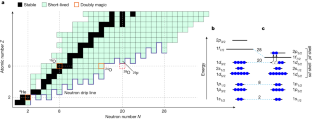2023-08-30 オークリッジ国立研究所(ORNL)
◆研究により、酸素28は非結合同位体であることが判明しました。また、コンピュータモデリングとシミュレーションを通じて、極端な条件下での核の振る舞いや新たな物理学の理解を追求しています。
<関連情報>
- https://www.ornl.gov/news/doubly-magic-rare-isotope-oxygen-28-cant-overcome-its-neutron-rich-instability
- https://www.nature.com/articles/s41586-023-06352-6
28Oの初観測 First observation of 28O
Y. Kondo,N. L. Achouri,H. Al Falou,L. Atar,T. Aumann,H. Baba,K. Boretzky,C. Caesar,D. Calvet,H. Chae,N. Chiga,A. Corsi,F. Delaunay,A. Delbart,Q. Deshayes,Zs. Dombrádi,C. A. Douma,A. Ekström,Z. Elekes,C. Forssén,I. Gašparić,J.-M. Gheller,J. Gibelin,A. Gillibert,G. Hagen,M. N. Harakeh,A. Hirayama,C. R. Hoffman,M. Holl,A. Horvat,Á. Horváth,J. W. Hwang,T. Isobe,W. G. Jiang,J. Kahlbow,N. Kalantar-Nayestanaki,S. Kawase,S. Kim,K. Kisamori,T. Kobayashi,D. Körper,S. Koyama,I. Kuti,V. Lapoux,S. Lindberg,F. M. Marqués,S. Masuoka,J. Mayer,K. Miki,T. Murakami,M. Najafi,T. Nakamura,K. Nakano,N. Nakatsuka,T. Nilsson,A. Obertelli,K. Ogata,F. de Oliveira Santos,N. A. Orr,H. Otsu,T. Otsuka,T. Ozaki,V. Panin,T. Papenbrock,S. Paschalis,A. Revel,D. Rossi,A. T. Saito,T. Y. Saito,M. Sasano,H. Sato,Y. Satou,H. Scheit,F. Schindler,P. Schrock,M. Shikata,N. Shimizu,Y. Shimizu,H. Simon,D. Sohler,O. Sorlin,L. Stuhl,Z. H. Sun,S. Takeuchi,M. Tanaka,M. Thoennessen,H. Törnqvist,Y. Togano,T. Tomai,J. Tscheuschner,J. Tsubota,N. Tsunoda,T. Uesaka,Y. Utsuno,I. Vernon,H. Wang,Z. Yang,M. Yasuda,K. Yoneda & S. Yoshida
Nature Published:30 August 2023
DOI:https://doi.org/10.1038/s41586-023-06352-6

Abstract
Subjecting a physical system to extreme conditions is one of the means often used to obtain a better understanding and deeper insight into its organization and structure. In the case of the atomic nucleus, one such approach is to investigate isotopes that have very different neutron-to-proton (N/Z) ratios than in stable nuclei. Light, neutron-rich isotopes exhibit the most asymmetric N/Z ratios and those lying beyond the limits of binding, which undergo spontaneous neutron emission and exist only as very short-lived resonances (about 10−21 s), provide the most stringent tests of modern nuclear-structure theories. Here we report on the first observation of 28O and 27O through their decay into 24O and four and three neutrons, respectively. The 28O nucleus is of particular interest as, with the Z = 8 and N = 20 magic numbers1,2, it is expected in the standard shell-model picture of nuclear structure to be one of a relatively small number of so-called ‘doubly magic’ nuclei. Both 27O and 28O were found to exist as narrow, low-lying resonances and their decay energies are compared here to the results of sophisticated theoretical modelling, including a large-scale shell-model calculation and a newly developed statistical approach. In both cases, the underlying nuclear interactions were derived from effective field theories of quantum chromodynamics. Finally, it is shown that the cross-section for the production of 28O from a 29F beam is consistent with it not exhibiting a closed N = 20 shell structure.



